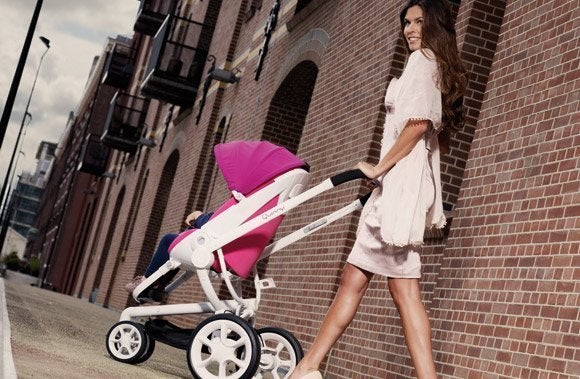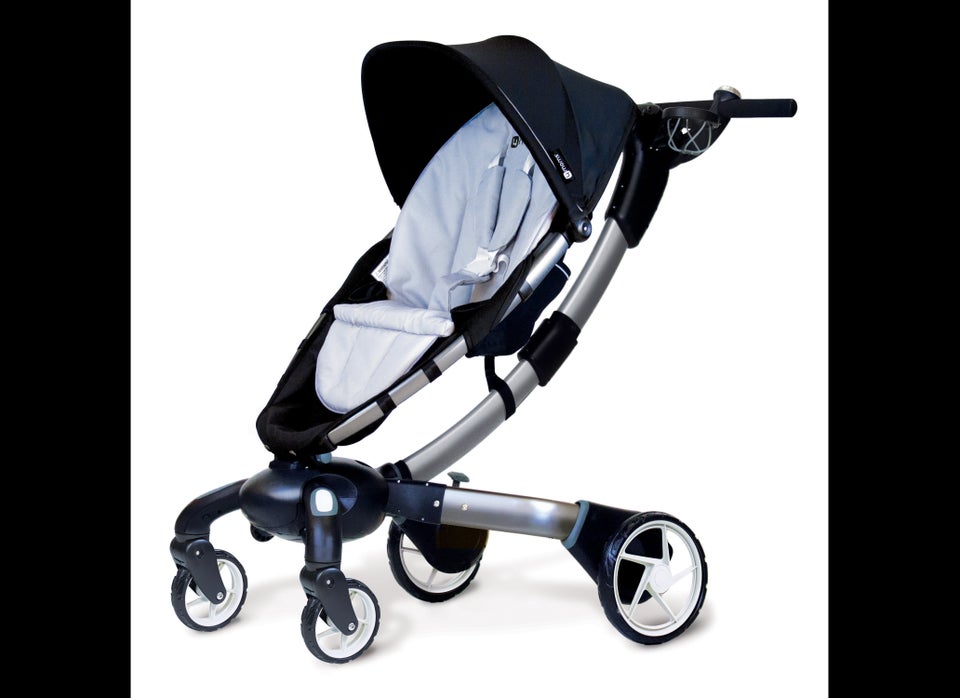
"Turn heads, turn corners."
It reads like a tagline for a luxury car, but the new advertising campaign behind those words -– featured beneath a red patent leather stiletto –- belongs to a brand called Quinny. The product it's pushing does have wheels, but it's a stroller.
The trademarks of baby products used to be primary colors, bulk and an overall aesthetic that was, well, childish. But several companies are moving toward sleek, design-conscious -- and expensive -- accessories meant to integrate into modern homes, and a mom's individual style, instead of taking them over.
"Sixty-eight percent of moms say that they want to be spoken to as more than just a mom," said Katherine Wintsch, founder of the Mom Complex, a think tank that researches what mothers want out of products and brings that information to companies. "The marketplace is responding to what (we found) moms were saying back in 2010, which was, 'I'm a whole human being. I'm an individual, not just a mother.'"
According to Wintsch, in the last year, there's been an onslaught of products and services moving away from "aprons and June Cleaver" and toward acknowledging some central themes: Moms have lives beyond their kids, they don't want their entire home to look like a nursery, and they don't lose all sense of style once they have children.
"It actually has very little to do with the baby, I think. These are infant products, and your child is pretty mute at that point," Wintsch said. "We hear moms all the time say, 'I want people to compliment me on my stroller as much as they would compliment me on my shoes.'"
Pairing a stiletto and a stroller together in an ad campaign starts to make a bit more sense when you think about it that way.
The marketing campaign for Jahgoo -- the company responsible for a product described as "first and foremost, an ergonomically designed potty" -- echos the sentiment:
"As a parent, you simply seem to tolerate all of these primary colors and blocky shapes around the house ... Why can't baby stuff be highly functional and elegantly or cleverly designed? What about space efficiency?"
A $300 high chair by Baby Bjorn is built on similar principles. The chair folds up so compactly that the company suggests parents can even travel with it. A baby bathtub by Boon is contemporary and minimalist in design, and also in its name: It's called the "Naked." The basin can be completely flattened and hung up to dry.
Of course, there's also the $850 Origami stroller by 4moms, which came out earlier this year. It automatically collapses with the push of a button -- and can charge your cell phone. In January, Wall Street Journal columnist Ralph Gardner wrote about confusing one he saw on Park Avenue with a UFO because of the lights under the carriage.
A U.K.-designed car seat called the Carkoon has a space-age feel to it, too. An airbag forms a cocoon over the baby in the event of an accident, and the seat is fireproof. (The Carkoon won't be on the market until the manufacturers can prove its safe).
Sandra Gordon, author of "Consumer Reports Best Baby Products" pointed out that predecessors to these sleeker baby products started to take off in 2005, after Bugaboo proved there was a market for higher-end strollers costing nearly $1,000.
"Bugaboo was like the gateway drug. Manufacturers realized they could make these high-end products and parents would actually buy them," Gordon said. "Then the recession hit and the birth rate dropped, and the industry was flat. I didn't see a lot of stylish stuff coming out. I see this stuff now and think oh my god, it's definitely a sign of the times."
Still, it remains to be seen whether some of these designs will become affordable. As Wintsch pointed out, 77 percent of Americans earn less than $75,000. "They're not gong to be able to buy a Baby Bjiorn high chair that’s $300," she said.
Nevertheless, in 2011, the baby-care products industry reached $44.7 billion, and it's estimated to be valued at $47.7 billion in 2012, according to a report published earlier this month by Transparency Market Research. The group said the numbers are being driven by people having their first child later in life -- and having more money to spend as a result. The report estimates that the market will be worth $66.8 billion five years from now.
Michal Clements, a principle at the Cambridge Group and co-author of "Tuning Into Mom," said parents are making their children in their own image. "It's believing that a kid's appearance is the statement on the parent," she said.
But according to Don McKinney, chief ideas officer with Barkley's which earlier this month co-authored a report on the consumer habits of millennial moms, there are some aspects of these products that can be explained by a broader movement on the part of manufacturers away from psychics-based designs to ones more rooted in biology.
"They're actually taking more cues from nature than they are from industry. It's all part of where design is going," said McKinney, who pointed to the 4moms mamaRoo chair, $200, which mimics how a mother sways when she holds her baby.
Then again, McKinney said there's a simpler explanation for the move towards higher-end items for children, but that it might come across as callous.
"Babies are more accessories these days," he said. "That’s the easy answer."
CORRECTION: A previous version of this story incorrectly referred to the Quinny Moodd stroller as having four wheels. It has three.
